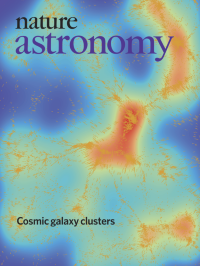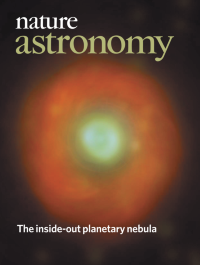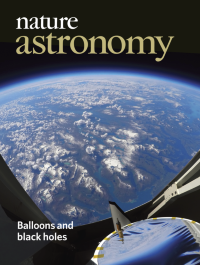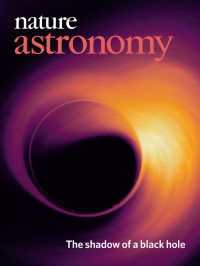Volume 2
-
No. 12 December 2018
Cosmic galaxy clustersDiscriminating between Einstein’s theory of general relativity and models of modified gravity is not easy at cosmological scales. The motions and clustering of galaxies (pictured) turn out to be a sensitive test of these cosmological models. Predictions from a simulation of the velocity field of galaxies based on general relativity agree well with observational data.
See He et al.
-
No. 11 November 2018
Bursting with potentialThe Australian Square Kilometre Array Pathfinder (ASKAP) is a fast new survey facility for the southern radio sky. Its 36 dishes and unique receiver technology give the array a wide field of view, with excellent sensitivity. This issue of Nature Astronomy features early results from ASKAP (see McClure-Griffiths et al.) and an overview of ASKAP’s capabilities in searching for fast radio bursts (see Mission Control).
See Bannister
-
No. 10 October 2018
The inside-out planetary nebulaHuBi 1 bucks the norm for a planetary nebula: its inner regions show emission from low-ionization potential species and its outer regions from high-ionization potential species. This unusual, inverted arrangement is the result of a very late thermal pulse that occurred just as the central star left the asymptotic giant branch.
See Guerrero et al.
-
No. 9 September 2018
Merger and turmoil in M31's pastCosmological models of galaxy formation show that M31’s massive and metal-rich stellar halo requires a single dominant merger with a large galaxy around two billion years ago. The fact that M31’s disk and bulge were already in place suggests that mergers of this magnitude need not dramatically affect galaxy structure.
See D'Souza & Bell
-
No. 8 August 2018
Balloons and black holesX-ray polarization observations of the stellar black hole in Cygnus X-1 by a balloon-borne telescope revealed weak polarization, whose angle is aligned with the jet axis. Together with previous data, these findings point to an accretion disk corona that is either extended or located far from the black hole.
See Chauvin et al.
-
No. 7 July 2018
The shadow of a black holeProperties of the shadow cast by a black hole due to extreme lensing should help discriminate between models of gravity. But simulations show that the silhouettes of a rotating Kerr black hole (general relativity) and a non-rotating black hole (with a dilaton field) are sufficiently similar that the Event Horizon Telescope cannot presently tell the difference.
See See Mizuno et al.
-
No. 6 June 2018
Hard as nailsUsing high-powered lasers at the US National Ignition Facility, iron has been compressed to 1.4 TPa in order to measure its equation of state under the extreme conditions it would experience at the core of a massive terrestrial planet. This result generates an experimentally based mass–radius relationship for a hypothetical pure-iron exoplanet.
See Smith et al.
-
No. 5 May 2018
No pristine cometsThe bilobate form of many cometary nuclei is usually associated with low-speed merging of two bodies occurring in the early phase of our Solar System. Simulations show another pathway to bilobate formation: aggregation of material after a catastrophic impact. This process can occur at any time, so bilobate comets don’t necessarily have to be primordial, as previously thought.
See Schwartz et al.
-
No. 4 April 2018
Perseus’s ancient edge still sharpIn the outer reaches of the Perseus galaxy cluster lies the five-billion-year-old relic ‘cold front’ produced by a cluster merger. Previously unseen structures found using deep Chandra X-ray Observatory images of this cold front provide powerful new insights into the astrophysics of galaxy clusters.
See Walker et al.
-
No. 3 March 2018
A window to the Martian pastPhyllosilicates (clays) on Mars, such as the light—toned outcrops at Mawrth Vallis shown on the cover, could form during warm and wet intermittent periods in a generally cold early Mars. This model solves the contradiction on the state of ancient Mars between mineralogical and geomorphological observations and the most accepted climate theories.
See Bishop et al. and News & Views by Bridges
-
No. 2 February 2018
Blooming jet instabilitiesHydrodynamical simulations of unmagnetized relativistic jets show that they develop a centrifugal instability—shown in cross-section in the cover image—during reconfinement by the intergalactic medium. This instability introduces turbulence in the jet and may explain the early disruption of some active galactic nuclei jets.
See Gourgouliatos et al.
-
No. 1 January 2018
Out of the ordinaryObservations of a dusty high-redshift (z = 6) galaxy reveal it to be more representative of ‘normal’ star-forming galaxies in the local Universe, rather than the extreme starbursts of a similar age discovered to date. The cover image is an interpretation of this distant lensed galaxy by young illustrator Elda FloMont.
See Zavala et al.












